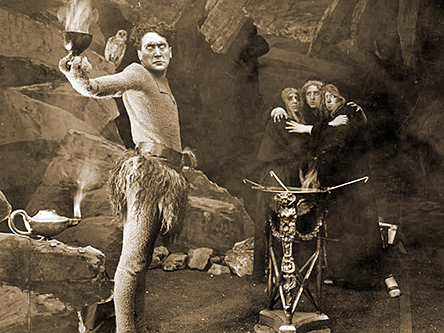| |
 |
| |
Mario Bonnard (left).
Photograph: Silent Era image collection.
|
Satana
Also known as Satana (Il dramma dell'umanità) in Italy; Saatana in Finland; Satan contre le créator et le diable vert in France; A sátán in Hungary; Satan, den store rebellen in Switzerland; Satan; or, The Drama of Humanity and as Satan, the Destroyer of Humanity in the USA
(1912) Italy
B&W : Seven reels
Directed by Luigi Maggi
Cast: Mario Bonnard [Satana], Mary Cléo Tarlatini [La cortigiana Fiammetta], Fernanda Negri Pouget [Maria, la fioraia], Mario Voller Buzzi (Mario Voller-Buzzi) [Gesù Cristo], Enrico Lupi [Furio], Margherita Albry (Rina Albry), Arrigo Amerio, Paolo Azzurri, Carlo Campogalliani, Filippo Castamagna, Vitale De Stefano (Vitale Di Stefano), Oreste Grandi, Antonio Grisanti, Enrico Negro, Lia Negro, Armando Pouget (Armand Pouget), Giuseppina Ronco, Bianca Schinini, Dario Silvestri, Ercole Vaser, Angelo Vestri, Enrico Vidali (Giovanni Enrico Vidali), Cesare Zocchi
Società Anonima Ambrosio production; distributed by [?] Società Anonima Ambrosio? / Produced by Arturo Ambrosio. Scenario by Friedrich G. Klopstock, from the epic poem Paradise Lost by John Milton. Cinematography by Giovanni Vitrotti. / Released 10 December 1912. / Standard 35mm spherical 1.33:1 format. / The film was released in Hungary as A sátán in January 1913. The film was released in France as Satan contre le créator et le diable vert on 24 January 1913. The film was released in the United Kingdom on 25 January 1913. The film was released in the USA as Satan; or, The Drama of Humanity by Ambrosio American Company on 26 January 1913. The film was released in Finland as Saatana on 16 March 1914. The film was released in Sweden on 2 October 1916.
Drama: Allegorical.
Synopsis: [Cinema News and Property Gazette, 15 January 1913, page ?] After the defeat of the rebel angels, Satan is sent to earth. Unable to reascend, he prepares to work his evil machinations on mankind. He begins immediately after the creation, tempting Adam and Eve, and causing them to sin. Having accomplished so much, he drives mankind to evil by teaching Cain and Abel to wield weapons, whereupon the first tragedy is enacted in the slaying of Abel by Cain, and sows the discontent that results in war. Nimrod, with the first sword manufactured, slays his father, and Cain carries off his daughter. Satan advises Nimrod to punish the woman, and through his evil promptings, the offering up of human sacrifice begins. Later the coming of the Messiah to Satan is a sight physically unbearable. The Evil One increases his activities, and is seen at work among the soldiers of Herod. His particular instrument, however, is Judas Iscariot, whom he entices to betray his Master. Great is the joy of Satan when the Savior is crucified, and greater still is his discomfiture as Jesus again walks forth into the light. Later, in a monastic laboratory, he teaches a weak-willed monk named Gerbert the art of distilling liquor from a herb, thereby inflicting upon the human race the curse of drink. Gerbert shows his delight at the discovery, and calls forth his brother monks to partake of the refreshing but accursed liquor, and turns the monastery of good work into a workshop of evil. Mephisto’s work during the medieval period is then taken up. His gradual development of the temptations of life that have been handed down to us is skillfully portrayed. The inevitable consequence of the immoderate use of money and wine are shown in a way that teaches a great lesson. The latter portion of the film deals with Satan at work among the peoples of modern times. While many of the sins of early days still continue with us, the spirit of evil has developed quite a number of new ones, and the great Steel King is seen as an agent of the devil, wrecking the lives of women and workers.
Survival status: (unknown)
Current rights holder: (unknown) [Italy]; Public domain [USA].
Listing updated: 4 January 2025.
References: Robinson-Palace p. 136; Tarbox-Lost p. 116 : Website-IMDb.
|




































